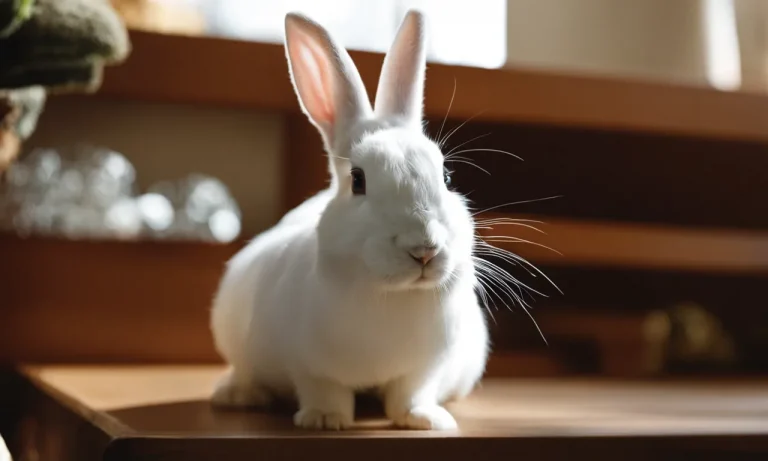Many rabbit owners wonder if it is safe to leave their bunnies outside overnight. Rabbits are prey animals that can be vulnerable to predators and temperature extremes when left unattended outside. If you’re short on time, here’s a quick answer to your question: leaving rabbits unsupervised outside at night is generally not recommended due to the many potential dangers.
In this comprehensive article, we will examine in detail the key considerations around leaving domestic rabbits outdoors after dark. We will cover the risks of predators, temperature regulation issues, safety of the rabbit enclosure, and steps you can take to try to mitigate risks if you must keep your rabbit outside at night.
Risk of Predators Attacking Rabbits at Night
Leaving your rabbit outside at night can pose risks as there are several nocturnal predators that can threaten their safety. It is important to consider these risks and take necessary precautions to ensure the well-being of your beloved pet.
Common nocturnal predators that can threaten pet rabbits
Rabbits are vulnerable to attacks from a variety of predators, especially during nighttime when they are more active. Some common nocturnal predators that pose a threat to rabbits include:
- Foxes: Foxes are known to be skilled hunters and can easily prey on rabbits. They are particularly cunning and can find their way into enclosures if not properly secured.
- Owls: Owls are silent predators that can swoop down and snatch rabbits from their outdoor enclosures. Their sharp talons and strong beaks can cause serious harm.
- Raccoons: Raccoons are intelligent and opportunistic predators that can easily break into enclosures in search of food. They can cause significant harm to rabbits if they manage to gain access.
- Coyotes: Coyotes are known to roam in both urban and rural areas, and they can pose a serious threat to rabbits. Their agility and hunting instincts make them a formidable predator.
Predation risk factors based on location
The risk of predation can vary depending on your location. For example, if you live in an area with a high population of foxes or coyotes, the risk of predation will be higher compared to areas with fewer predators.
Similarly, if you live near wooded areas or open fields, the likelihood of encountering nocturnal predators increases.
It is important to research and understand the specific predators in your area to assess the level of risk your rabbit may face. Local wildlife organizations or animal control agencies can provide valuable information about the predators in your region.
Securing enclosures against predators
To protect your rabbit from nocturnal predators, it is crucial to secure their enclosures properly. Here are some measures you can take:
- Secure fencing: Use sturdy, predator-proof fencing made of materials that cannot be easily chewed through or dug under.
- Secure lids: Ensure that the top of the enclosure is covered with a secure lid or mesh to prevent owls or other birds of prey from accessing your rabbit.
- Bury wire mesh: Burying wire mesh around the perimeter of the enclosure can prevent predators from digging their way in.
- Use motion-activated lights or alarms: Installing motion-activated lights or alarms can deter predators from approaching the enclosure.
By implementing these precautions, you can significantly reduce the risk of predators attacking your rabbit at night and provide them with a safe outdoor environment.
Challenges for Rabbits Regulating Body Temperature Overnight
Rabbits struggle with hot temperatures
Leaving a rabbit outside at night can pose several challenges when it comes to regulating their body temperature. Rabbits are highly sensitive to heat and can struggle to cool down, especially during hot summer nights.
They do not have the ability to sweat like humans do, making it difficult for them to dissipate heat. This can lead to heat stress or even heat stroke, which can be life-threatening for rabbits.
Rabbits have a thick coat of fur, which can further exacerbate the issue of overheating. Their fur acts as insulation, trapping heat close to their bodies. When left outside at night, rabbits may not have access to cool areas or shade, making it even harder for them to regulate their body temperature.
It is important to ensure that rabbits are kept in a cool and well-ventilated environment, especially during hot summer nights.
Rabbits struggle with cold temperatures
On the other end of the spectrum, rabbits also struggle with cold temperatures. Rabbits are more susceptible to hypothermia, a condition where their body temperature drops below normal levels, during chilly nights. Their small size and lack of body fat make it harder for them to retain heat.
Rabbits are also prone to frostbite, particularly in their ears and extremities, when exposed to freezing temperatures for prolonged periods.
Leaving a rabbit outside at night during cold weather can put their health at risk. It is important to provide adequate shelter and insulation to keep them warm. This can include providing a cozy hutch with straw or hay bedding, ensuring the enclosure is draft-free, and even using heat lamps or heating pads in extreme cold conditions.
Regularly monitoring the temperature and taking necessary precautions can help prevent hypothermia and other cold-related issues.
Tips for regulating temperature in outdoor rabbit enclosures
If you choose to keep your rabbit outside at night, there are several steps you can take to help them regulate their body temperature more effectively:
- Provide ample shade and cool areas for hot summer nights.
- Ensure the enclosure is well-ventilated to allow for air circulation.
- Use a fan or misting system to help cool down the air around the enclosure.
- Provide plenty of fresh water to keep your rabbit hydrated.
- During cold nights, provide insulation such as straw or hay bedding.
- Use heat lamps or heating pads in extreme cold conditions, but ensure they are safe and not a fire hazard.
- Regularly monitor the temperature and make necessary adjustments to keep your rabbit comfortable.
Remember, rabbits are sensitive creatures and their well-being should always be a top priority. If you are unsure about leaving your rabbit outside at night, it may be best to provide them with a comfortable indoor enclosure where you can better control the temperature and environment.
Key Considerations for Outdoor Rabbit Housing Safety
When it comes to housing your rabbit outdoors, there are several key considerations to keep in mind to ensure their safety and well-being. While rabbits are known to thrive in outdoor environments, it’s important to provide them with the proper shelter, space, and materials to ensure their comfort and protection.
Providing shelter from the elements
Rabbits are sensitive to extreme temperatures, so it’s crucial to provide them with adequate shelter from the elements. A sturdy hutch or a rabbit-proof shed can serve as a safe haven for your furry friend.
Make sure the shelter is well-insulated and offers protection from rain, wind, and direct sunlight. You can also provide additional insulation during colder months with straw or blankets to keep your rabbit warm and cozy.
Adequate space for exercise
Rabbits are active animals that require plenty of space for exercise and movement. When housing your rabbit outdoors, ensure that they have enough room to hop, run, and stretch their legs. A spacious outdoor enclosure or a securely fenced yard can provide the necessary space for your rabbit to explore and engage in natural behaviors.
Remember, a bored rabbit can become stressed or develop behavioral issues, so providing ample space is essential.
Materials to avoid
When choosing materials for your outdoor rabbit housing, it’s important to avoid those that may pose a threat to your rabbit’s health. For example, cedar and pine wood shavings can release harmful chemicals and oils that can irritate your rabbit’s respiratory system.
Instead, opt for safer bedding materials such as aspen or paper-based products. Additionally, avoid using wire flooring in your rabbit’s enclosure, as it can cause discomfort and potentially lead to foot injuries.
Lighting needs
While rabbits are crepuscular animals, meaning they are most active during dawn and dusk, it’s important to provide adequate lighting in their outdoor housing. This is particularly crucial during the winter months when daylight hours are shorter.
Consider installing outdoor lighting or providing a source of artificial light to ensure your rabbit has enough visibility and can maintain their natural sleep-wake cycle.
Remember, always prioritize the safety and comfort of your rabbit when making decisions about their housing. If you’re unsure about any aspect of outdoor rabbit housing, consult with a veterinarian or an experienced rabbit owner for guidance.
By providing the right shelter, space, and materials, you can create a safe and enjoyable outdoor environment for your beloved furry companion.
Mitigation Steps if You Must Leave Rabbits Outside at Night
While it is generally recommended to bring rabbits indoors at night for their safety and well-being, there are certain situations where leaving them outside becomes necessary. In such cases, it is important to take certain steps to mitigate any potential risks or dangers.
Here are some mitigation steps to consider if you must leave your rabbits outside at night:
1. Bring rabbits indoors when extreme weather is forecast
Rabbits are sensitive to extreme weather conditions, so it is crucial to bring them indoors when severe weather is expected. This includes extreme temperatures, strong winds, heavy rain, or snowstorms. Rabbits can easily become stressed or suffer from hypothermia or heatstroke in such conditions.
It is always better to prioritize their safety and provide them with a comfortable and controlled environment indoors.
2. Provide hiding spaces
Rabbits are prey animals and are naturally cautious and timid. To help them feel secure when left outside at night, provide them with hiding spaces. This could include rabbit-sized shelters, boxes, or even large plant pots turned on their sides.
These hiding spaces will give your rabbits a sense of security and help protect them from potential predators.
3. Use predator-proof fencing and enclosures
One of the biggest concerns when leaving rabbits outside at night is the risk of predation. To minimize this risk, it is important to use predator-proof fencing and enclosures. Ensure that the fencing is buried at least a foot underground to prevent predators from digging underneath.
Additionally, use mesh or wire that is small enough to keep out predatory animals like raccoons or foxes. Regularly inspect the fencing for any gaps or damage and repair them promptly.
4. Consider supervised time outdoors
If you are unable to bring your rabbits indoors at night, consider supervised time outdoors during the day. This allows your rabbits to enjoy the fresh air and exercise while keeping a close eye on them. Ensure the area is secure, and there are no potential hazards or escape routes.
Remember, rabbits are social animals and need companionship, so spending time with them during their outdoor activities can provide both mental and physical stimulation.
Remember, while these mitigation steps can help reduce risks, it is still highly recommended to bring rabbits indoors at night for their safety and well-being. Rabbits are vulnerable animals and should be provided with a secure and comfortable environment.
Conclusion
In summary, most rabbit experts advise against leaving domestic rabbits unattended outside at night due to the risks. Rabbits are vulnerable prey animals and have difficulty regulating their body temperature, making nights especially hazardous.
If keeping your rabbit indoors is not possible, take every precaution to protect them from predators, temperature extremes, and other threats. Supervise outdoor time whenever possible, and bring rabbits inside if risky weather conditions arise.
With careful planning, secure housing, and mitigation steps, some rabbit owners find it can work to allow rabbits limited supervised time outdoors after dark. However, uncontrolled all-night access is difficult to make truly safe for our domestic companions.






